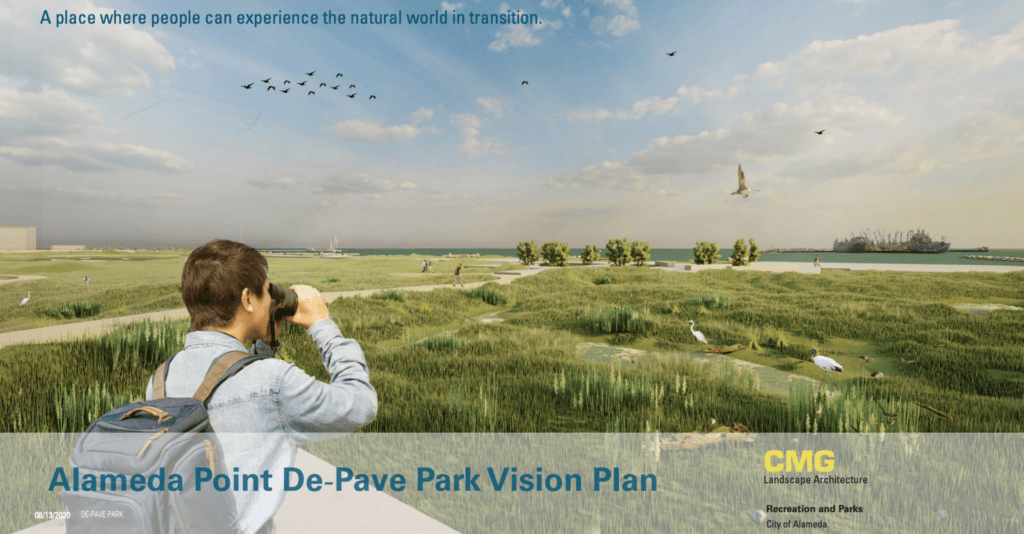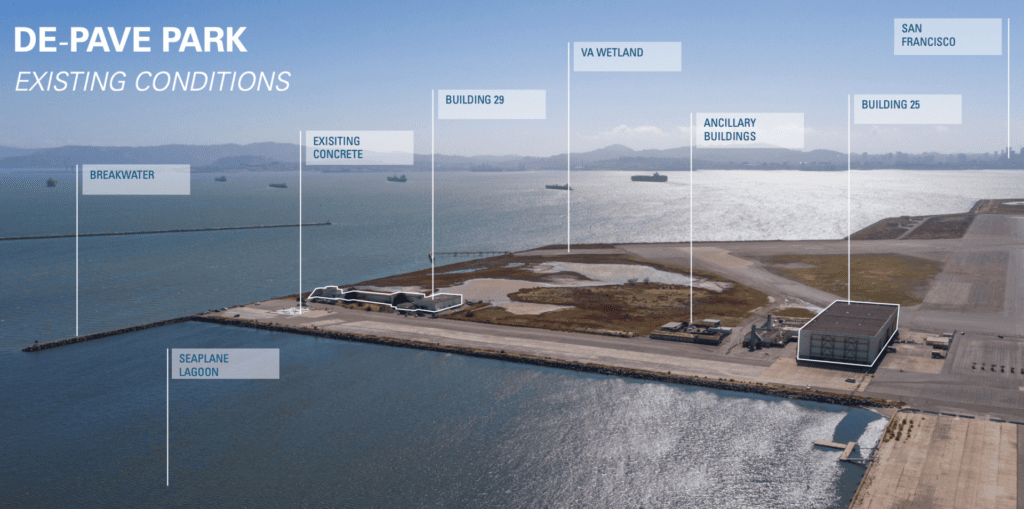De-Pave Park in Alameda: A Win for the Birds
By Sharol Nelson-Embry and Linda Carloni
Last night was a win for the birds as the Alameda City Council voted four-to-one in favor of offering the maximum amount of wildlife habitat at “a “De-Pave Park”, a planned nature park on a section of the former Naval Air Station, now called Alameda Point. At least seven speakers talked passionately and eloquently about how the removal of the existing structures was important in creating the largest habitat possible for birds and other wildlife, as well as a shoreline that will accommodate sea-level rise, sequester carbon, and provide a place for people to enjoy nature and the expansive views of San Francisco.

De-Pave Park has been in the works since 2014, when it was first proposed to remove the paving on a section of the old Naval Air Station (thus the name, “De-Pave”) and create a nature-oriented park with public access and intertidal connection. The process included extensive public outreach to people and businesses from throughout Alameda including; Friends of the Alameda Wildlife Reserve (FAWR) – the GGBA Conservation Committee for the City of Alameda – as well as our allies from the Sierra Club, Baykeeper, and Community Action for a Sustainable Alameda (CASA). During the process, the City, partnering with Literacy for Environmental Justice, received an $800,000 grant from the San Francisco Bay Restoration Authority (Measure AA funding). The grant funds a community stewardship program, completion of a master plan and 30% of the design plans.
The most recent planning phase gathered public input on the options of retaining one of the structures and its support buildings, referred to as Building 25, with a large section of land around it protected by a levee (Option 1); or retaining Building 25 with a reduced section of land still protected by a levee (Option 2); or demolishing Building 25 and using the additional three acres to create a larger nature park (Option 3). FAWR, alongside its allies, has worked hard to support Option 3 with letters written by GGBA Executive Director, Glenn Phillips, our allies and our FAWR members. We’ve gone to multiple meetings and spoken to support the full nature park afforded by Option 3, and written articles for the local newspapers and online news outlet, the Alameda Post to educate Alameda residents about the importance of creating new wetlands for the birds.

Last night the City Council approved Option 3 and directed staff to move forward with planning for a new nature park, taking into account the current tenants and directing staff to work to find them other spaces at Alameda Point.
As noted before, many, many people and organizations worked to get De-Pave Park this far. We’d like to add a special shout-out to Richard Bangert of the Sierra Club, a long-time and fierce advocate for De-Pave Park; CMG Landscape Architects, who provided outstanding design and planning services; and the leadership and staff of the Alameda Recreation and Parks Department.

Our shorebirds and other wildlife will benefit from the new habitat, replacing just a fraction of the vast acreage lost over the last 150 years – an estimated 90% of historical wetlands around San Francisco Bay. The nesting California Least Terns, an endangered species that has nested at Alameda Point since the 1970s, will benefit from additional fishing habitat closer to their nest site. The existing buildings will no longer harbor predatory birds such as Peregrine Falcons and Red-tailed Hawks that use the buildings for perches to hunt the Least Terns and their young. And the view across the bay will be unobstructed, enhancing people’s enjoyment of the park. We applaud the four City Council members who showed leadership and vision in prioritizing nature and accommodating future sea-level rise in moving forward to create this distinctive park in our City.
Sharol Nelson-Embry recently retired after 35 years as an interpretive naturalist, the last 26 as a Supervising Naturalist for the East Bay Regional Parks District, where she directed the Crab Cove Visitor Center and Aquarium in Alameda. In addition to her extensive experience as an outdoor educator, Sharol has a BS in Natural Resources Management from Cal Poly, SLO, and completed her Master Birder certificate in 2021.
Linda Carloni is retired from the practice of law, most recently as General Counsel of an Oakland educational software company. Linda presently serves as Co-Chair of the Friends of the Alameda Wildlife Reserve Committee.
